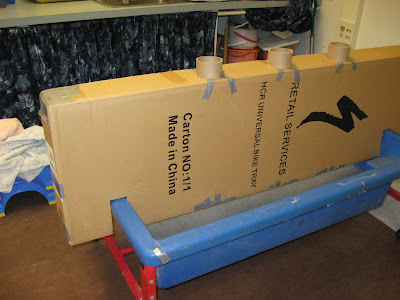I build apparatus at the sensory table to make the space more inviting and more intriguing for children's play and exploration. I use various orientations and various elements in each of the constructions. For instance, in the box tower pictured below, I oriented a tall box on a vertical plane rising up from the table. Since the vertical tower was embedded in a wider, lower box for stability, I also created a horizontal surface around the tower on which the children could do their operations. In addition, I cut holes on multiple levels so the children could put things in and pull things out of the holes.
In essence, I created a space that was open-ended and rich in possibilities. For the children, there was no prescribed way to use the apparatus. As a consequence, they were able to author their own scenarios about what this contraption could be. And in that process, they were able to touch on all areas of development: physical (scooping and pouring); social (let's make a machine); cognitive (what fits in which hole?) and language and literacy. In this post, I want to focus on this last area of development.
Here is a picture of that same tower apparatus from a different perspective. This perspective shows the wall behind the installation. One particular group decided that this construction was a machine for making food. I was so fascinated by what they said they were making, I put two sheets of large paper on the wall to record what they said.

Here is a closeup of two of those recipes. For one child, the tower was a "pancake factory" that made softer pancakes. There seemed to be a lot of free association with this child's recipe. The second child made a chocolate pie. He, too, seemed to engage in a lot of free association.
The second child was especially proud of his recipe---I think he must have been watching the food channel---so he asked for a piece of paper and a marker. He proceeded to write his name and then asked for tape so he could tape it next to his recipe. This was his recipe and he wanted everyone to know that it was his recipe.
This was a rich literacy experience for a couple of reasons. First and foremost, I wrote down exactly what the children said in real time. Second, I asked the children if I could read the recipe back to them. They always said yes and seemed quite pleased with their recipes, especially the silly parts. By paying such close attention to the first child's words and writing them down, other children wanted me to write down their recipes. And finally, it prompted one child to write his own name. Not only was it a rich literacy experience, it was also an authentic literacy experience coming from the children themselves.
The very first time I recorded what a child said at the sensory table was back in 2003. The apparatus was a wooden tray that spanned the width of the table. The table had water, rocks and various implements and containers.
Below is what I recorded. The interesting aspect of this episode is that I asked a lot of questions for clarification and made comments instead of just listening to the child and recording what she said.
Did my questions and added comments really get at her thinking? Or did the questions and comments prompt her responses and guide her thinking?
There was always a tension that I tried to navigate between academics and play. Earlier in my career, I felt like I had to find a way to justify play by pointing out what the children were learning through play. Later in my career, I felt there was tremendous value to be in the same space that children inhabited when they played. That way, I could focus on what the children were doing rather than directing or even affecting the trajectory of their endeavors.
Literacy moments will happen whether I highlight them or not. Maybe for me, the flow of the children's play and exploration became more important than trying to impose some sort of literacy lesson on what they were doing.



















